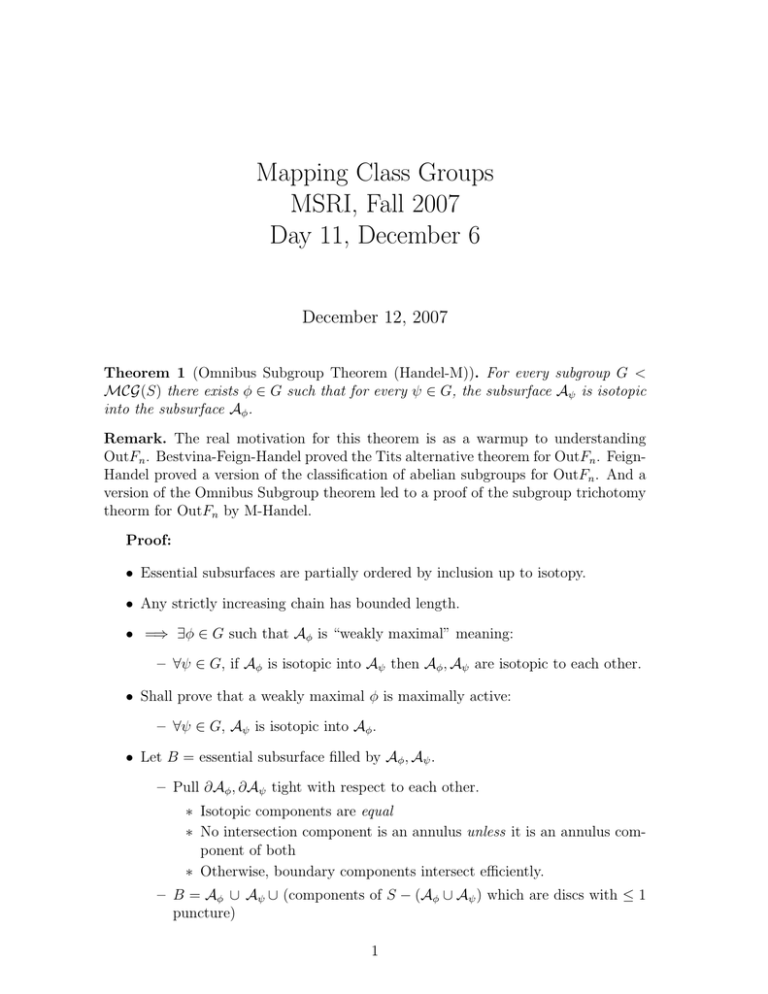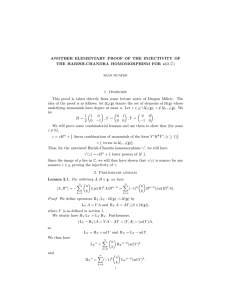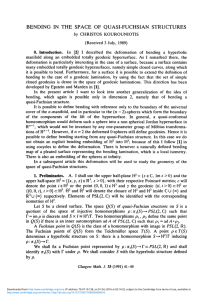Mapping Class Groups MSRI, Fall 2007 Day 11, December 6 December 12, 2007
advertisement

Mapping Class Groups
MSRI, Fall 2007
Day 11, December 6
December 12, 2007
Theorem 1 (Omnibus Subgroup Theorem (Handel-M)). For every subgroup G <
MCG(S) there exists φ ∈ G such that for every ψ ∈ G, the subsurface Aψ is isotopic
into the subsurface Aφ .
Remark. The real motivation for this theorem is as a warmup to understanding
OutFn . Bestvina-Feign-Handel proved the Tits alternative theorem for OutFn . FeignHandel proved a version of the classification of abelian subgroups for OutFn . And a
version of the Omnibus Subgroup theorem led to a proof of the subgroup trichotomy
theorm for OutFn by M-Handel.
Proof:
• Essential subsurfaces are partially ordered by inclusion up to isotopy.
• Any strictly increasing chain has bounded length.
• =⇒ ∃φ ∈ G such that Aφ is “weakly maximal” meaning:
– ∀ψ ∈ G, if Aφ is isotopic into Aψ then Aφ , Aψ are isotopic to each other.
• Shall prove that a weakly maximal φ is maximally active:
– ∀ψ ∈ G, Aψ is isotopic into Aφ .
• Let B = essential subsurface filled by Aφ , Aψ .
– Pull ∂Aφ , ∂Aψ tight with respect to each other.
∗ Isotopic components are equal
∗ No intersection component is an annulus unless it is an annulus component of both
∗ Otherwise, boundary components intersect efficiently.
– B = Aφ ∪ Aψ ∪ (components of S − (Aφ ∪ Aψ ) which are discs with ≤ 1
puncture)
1
2
Figure 1: Pulling Aφ and Aψ tight.
Figure 2: Add discs or punctured discs to Aφ ∪ Aψ
Reduction: Shall produce φm ψ n ∈ G whose active subsurface is the surface B
filled by Aφ , Aψ .
This finishes the proof, because:
• Aφ ⊂ B, so weak maximality =⇒ Aφ = B.
• Aψ ⊂ B, so Aψ ⊂ Aφ as desired.
How to produce the desired φm ψ n :
• May choose Φ, Ψ representing φ, ψ to be the finite order homeomorphism when
restricted to S − Aφ and S − Aψ , respectively.
• Passing to powers, may assume Φ, Ψ are the identity on S − Aφ , S − Aψ respectively.
• Follows that Φ, Ψ are the identity on S − B.
• Working component-by-component, may assume B is connected.
• Easy case: B is an annulus, then it is a component of Aφ and of Aψ , the
restrictions are Dehn twists, and the rest is easy. (We have previously proved
that in this case φ and ψ or ψ −1 have powers which agree).
• Easy case: B is a nonannulus isotopic to a component of Aφ and of Aψ , and
the restricted pseudo-Anosov homeomorphisms have the same stable-unstable
lamination pair; the rest is easy.
• General case: B is a nonannulus, Aφ , Aψ together fill B, and φ, ψ B are not
pseudo-Anosov with the same lamination pair.
3
The whole problem is therefore reduced to the following special case:
Lemma 2 (Filling Lemma). Suppose φ, ψ ∈ MCG(S) are infinite order and the
essential subsurfaces Aφ , Aψ jointly fill S. Suppose furthemore that if φ, ψ are both
pseudo-Anosov then they have different lamination pairs. Then there exist m, n ≥ 1
such that φm ψ n is pseudo-Anosov.
This result is in the works of Ivanov and of McCarthy, and plays essentially the
same technical role in their presentations that it is playing for us.
Their proof uses generalized source-sink dynamics on the Thurston boundary.
Our proof (Handel-M) will use laminations and Nielsen theory, and ideas from the
Bestvina-Feighn-Handel proof of the Tits alternative for Out(Fn ).
Quick idea of proof of the Filling Lemma:
• Let ξ = φm ψ n (for appropriately chosen m, n).
• For every essential simple closed curve γ on S, we shall show
– either “ξ k (γ) grows exponentially as k → +∞”,
– or “ξ −k (γ) grows exponentially as k → +∞”.
• In either case, it is impossible that ξ k (γ) = γ for any k.
• Therefore the mapping class ξ must be pseudo-Anosov.
• The two “. . . grows exponentially. . . ” phrases shall be defined in terms of attracting and repelling laminations.
Given φ ∈ MCG(S),
Λ+ (φ) = the attracting lamination of φ = union of pseudo-Anosov unstable foliations on nonannulus components of Aφ and union of core circles of annulus components of Aφ .
Λ− (φ) = the repelling lamination of φ = Λ+ (φ−1 ).
Note that the core circle of an annulus component of Aφ is in both of the laminations Λ+ (φ), Λ− (φ), and these are the only leaves in common.
Fix a hyperbolic structure on S.
Given a simple closed geodesic γ, we want to know:
how much of γ stays close to Λ+ (φ) or to Λ− (φ)?
Given:
Λ = a geodesic lamination Λ (such as Λ+ (φ), Λ− (φ))
γ = a simple closed geodesic
L ≥ 1 a positive integer
>0
Define:
N (γ, Λ; L, ) = maximal number of disjoint subsegments α ⊂ γ of length L such that
each tangent vector on α is within distance of a tangent vector on Λ.
4
Figure 3: The black lines are leaves of the lamination Λ and the thick red-green curve
is some simple closed curve on the surface. The red parts are the L-long subsegmants
which are close to the lamination.
The “Stretching Lemma” says that as we iterate ξ = φm ψ n on the curve γ, and
we compute this number with respect to one of the two lamination Λ+ (φ) or Λ− (ψ),
then for one of the two computations we see exponential growth.
Note: we are not directly proving exponential growth of the length of γ. This is
an a posteriori consequence, but it is not the method of proof.
Lemma 3 (Stretching lemma).
If φ, ψ ∈ MCG(S) and Aφ , Aψ fill S, then there exist m, n > 0 such that if ξ = φm ψ n ,
then there exists L, , A > 0, B > 1 such that, for all simple closed geodesic γ = γ0 ,
defining γi to be the s.c. geodesic isotopic to ξ i (γ), there exists η ∈ {−1, +1} such
that one of the following holds:
i
• N (γi ; Λ+
φ , L, ) ≥ AB for i ≥ 1
i
• N (γ−i ; Λ−
ψ , L, ) ≥ AB for i ≥ 1
The Filling Lemma is an immediate consequence (because no γ is ξ periodic).
Outline of proof of Stretching Lemma:
• The two subsurfaces Aφ , Aψ fill S, so γ intersects at least one of them.
• Let’s look at cases to see how γ can be stretched:
– A special case where γ under which ξ = φm ψ n stretches γ.
– A special case under which ξ −1 = ψ −n φ−m
stretches γ.
• We analyze what happens when these two special cases fail.
5
Λ+
φ
Λ−
ψ
+
Figure 4: The red segment is γ 0 where γ is close to Λ+
φ . It is not too close to Λψ so
it intersects some of its leaves.
• Special case: N (γ, Λ+
φ ; L, ) ≥ 1.
Remark. One can fix to be the Margulis constant and only vary L in the
proof to get the result.
• If L >> 0, then γ intersects Aψ along a subarc γ 0 which is not too close to Λ−
ψ
−
(uses that Aφ , Aψ fill) (Otherwise take L → ∞ and get that Λ+
and
Λ
share
a
φ
ψ
leaf which is impossible for distinct minimal laminations, note that L, and the
“not too close” constant depend on φ and ψ but not on γ).
• If n >> 0 then image under ψ n of γ 0 has at least 2 segments α of length ≥ L
within of Λ+
ψ .(Here we make use of Neilsen Theory)
• If L >> 0 then each such α intersects Aφ along a subarc α0 which is not too
close to Λ−
φ.
• If n >> 0 then image under φm of β 0 has at least 2 segments γ of length ≥ L
within of Λ+
φ.
• Iterating this argument we conclude
+
i−1
– If N (γ0 , Λ+
.
φ ; L, ) ≥ 1 then for i ≥ 1 we have N (γi , Λφ ; L, ) ≥ 4
To make this argument rigorous, apply:
Theorem 4 (Nielsen Theory). Given ψ ∈ MCG(S) and component F of Aψ :
• If F is a nonannulus component, if Ψ represents ψ and is a pseudo-Anosov
on F , if x ∈ F is a fixed point with k stable and k unstable separatrices, if
1
e : H2 → H2 is a lift of Ψ fixing a lift x̃ of x, then the action of Ψ
e on S∞
Ψ
= ∂H2
has alternating source-sink dynamics with k sources and k sinks.
• If F is an annulus component, if Ψ represents ψ, fixes the core curve α of F ,
e : H2 → H2 is a lift of Ψ fixing
and twists each half of F − α at least once, if Ψ
1
e on S∞
a lift α̃ of α, then the action of Ψ
has “shear dynamics” (see figure)
6
1
0
0
1
11
00
φen (e
γ)
11
00
00
11
1
0
0
1
x
e
1
0
0
1
1
0
Figure 5: The blue points on ∂H2 are sinks for φ and the green points are sources
en γ )
for ψ. γ ∈ N (γ0 , Λ+
φ ; L, ) ≥ 1 then can uniformly bound the endpoints of φ (e
e − . Hence can find an m such that the endpoints of
away from the fixed points of Λ
ψ
ψem (φen (e
γ )) are uniformly close to the attracting fixed points of ψe
11
00
ψem (γ)
γ
e
11
00
Figure 6: A Dehn twist has shear dynamics: contracts a half neighborhood of a fixed
point and expands the other half. A large inough power of ψe will move γ
e’s endpoints
tward its fixed points.
7
Given a subarc γ 0 of γ as in the earlier argument, which is not too close to Λ− (Ψ)
on F ,
we obtain a lift γ
e somewhat close to x̃, but whose endpoints are not too close to
e
sources of Ψ.
Under a sufficiently large iterate,
e m (e
e
the endpoints of Ψ
γ ) are very close to sinks of Ψ,
m
e (e
e + (Ψ).
and so Ψ
γ ) has a very long segment close to segments of Λ
We have now proved the Stretching Lemma in two special cases:
• N (γ, Λ+
φ ; L, ) ≥ 1 (what we just did)
−1
• N (γ, Λ−
ψ ; L, ) ≥ 1 (same argument applied to ξ ).
Remains to analyze what happens when these fail,
for example when
N (γ, Λ−
ψ ; L, ) = 0
• γ must intersect some component F of Aψ
−
• Since N (γ, Λ−
ψ ; L, ) = 0, γ is not too close to the “compressing lamination Λψ .
• image under ψ n of γ 0 has at least 1 segments α of length ≥ L within of Λ+
ψ.
(similar Nielsen theoretic argument)
• If L >> 0 then α intersects Aφ along a subarc α0 which is not too close to Λ−
φ.
• If n >> 0 then image under φm of α00 has at least 2 segments γ of length ≥ L
within of Λ+
φ . (SAME Nielsen theoretic argument)
Conclusion:
• If Special Cases fail then N (γ0 , Λ−
ψ ; L, ) = 0
• =⇒ N (γ1 , Λ+
ψ ; L, ) ≥ 1, which falls under the special case.








